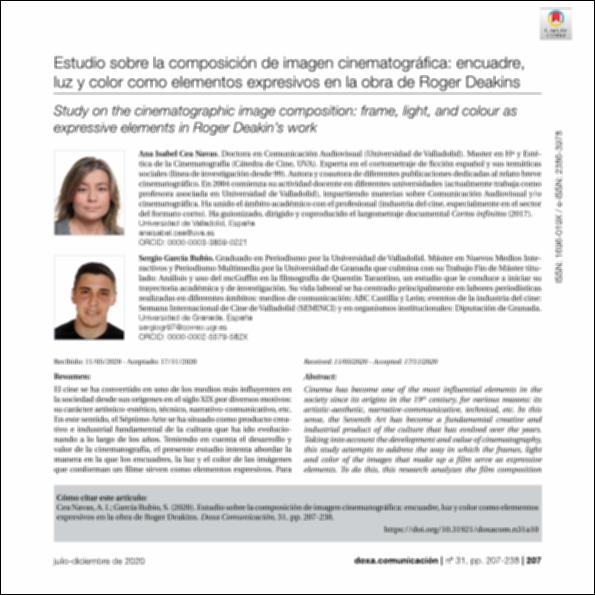Por favor, use este identificador para citar o enlazar este ítem:
http://hdl.handle.net/10637/11749Estudio sobre la composición de imagen cinematográfica: encuadre, luz y color como elementos expresivos en la obra de Roger Deakins.

Ver/Abrir:
es_a10_stamped.pdf
Español
3,35 MB
Adobe PDF
Ver/Abrir:
en_a10_stamped.pdf
English
2,73 MB
Adobe PDF
Ver/Abrir:
Articulo_10_ES_Doxa_31_Estudio_sobre_la_composicion_EPUB.epub
Español
2,81 MB
EPUB
Ver/Abrir:
Articulo_10_EN_Doxa_31_Study_on_the_cinematographic_EPUB.epub
English
1,94 MB
EPUB
| Título : | Estudio sobre la composición de imagen cinematográfica: encuadre, luz y color como elementos expresivos en la obra de Roger Deakins. Study on the composition of cinematographic image: frame, light, and color as expressive elements in the work of Roger Deakins |
| Autor : | Cea Navas, Ana Isabel García Rubio, Sergio |
| Materias: | Director de fotografía.; Luz-iluminación.; Color.; Encuadre.; Director of photography.; Light-ilumination.; Frame. |
| Resumen : | El cine se ha convertido en uno de los medios más influyentes en
la sociedad desde sus orígenes en el siglo XIX por diversos motivos:
su carácter artístico-estético, técnico, narrativo-comunicativo, etc.
En este sentido, el Séptimo Arte se ha situado como producto creativo e industrial fundamental de la cultura que ha ido evolucionando a lo largo de los años. Teniendo en cuenta el desarrollo y
valor de la cinematografía, el presente estudio intenta abordar la
manera en la que los encuadres, la luz y el color de las imágenes
que conforman un filme sirven como elementos expresivos. Para ello, esta investigación analiza el trabajo de composición cinematográfica de Roger Deakins en cuatro de sus obras: Fargo, El hombre que nunca estuvo allí, Sicario y Blade Runner 2049. Asimismo,
planteamos también si el camarógrafo tiene un estilo definido. Paralelamente, pretendemos poner en relieve el oficio del director de
fotografía, como figura encargada de la construcción del cuadro
del relato fílmico. Cinema has become one of the most influential elements in the society since its origins in the 19th century, for various reasons: its artistic-aesthetic, narrative-communicative, technical, etc. In this sense, the Seventh Art has become a fundamental creative and industrial product of the culture that has evolved over the years. Taking into account the development and value of cinematography, this study attempts to address the way in which the frames, light and color of the images that make up a film serve as expressive elements. To do this, this research analyzes the film composition work of Roger Deakins in four of his works: Fargo, The Man Who Wasn´t There, Sicario and Blade Runner 2049. Likewise, we also ask whether the cameraman has a defined style. At the same time, we intend to highlight the profession of the cinematographer, as the figure in charge of constructing the frame of the film narrative. |
| Descripción : | En: Doxa Comunicación: revista interdisciplinar de estudios de comunicación y ciencias sociales. e-ISSN 2386-3978 n. 31, 2020, pp 207-238. |
| URI : | http://hdl.handle.net/10637/11749 |
| Derechos: | http://creativecommons.org/licenses/by-nc-nd/4.0/deed.es |
| Fecha de publicación : | 11-dic-2020 |
| Centro : | Universidad San Pablo-CEU |
| Aparece en las colecciones: | Doxa.Comunicación nº 031 (2020) |
Los ítems de DSpace están protegidos por copyright, con todos los derechos reservados, a menos que se indique lo contrario.

